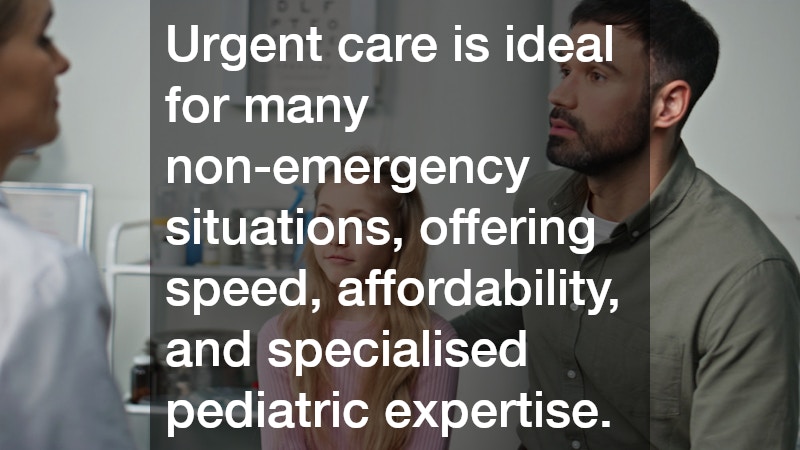When your child suddenly falls ill or suffers an injury, deciding where to seek treatment can feel overwhelming. Many parents struggle with whether they should head straight to the emergency room or opt for pediatric urgent care. Understanding the distinction between these two healthcare options is essential for making informed decisions and ensuring children receive the right level of care. This article explains the most common scenarios, cost considerations, and practical steps that can help parents feel more confident when choosing between these services.
What Situations Call for Pediatric Urgent Care?
Pediatric urgent care is designed for conditions that are not life-threatening but still require prompt attention. Examples include ear infections, minor cuts needing stitches, fevers, sprains, rashes, and sore throats.
These clinics offer an excellent alternative when your child’s symptoms cannot wait for a regular pediatrician’s appointment but do not rise to the level of a medical emergency. Many families appreciate that urgent care centers provide convenient hours, often including evenings and weekends, which makes them accessible when primary offices are closed.
Parents also benefit from faster service at pediatric urgent care compared to the long waits that often occur in crowded emergency departments. In addition, urgent care is usually more cost-effective, with lower co-pays and out-of-pocket fees than ER visits. Another advantage is that many of these clinics employ specialists trained in pediatrics who understand the unique needs of children. This combination of affordability, speed, and expertise makes urgent care an excellent option in many situations.
When Should You Head to the Emergency Room?
While pediatric urgent care handles many non-critical issues, some situations demand immediate attention at the emergency room. Severe conditions such as difficulty breathing, uncontrolled bleeding, seizures, head trauma, or signs of a broken bone with visible deformity should never be delayed. If your child experiences chest pain, persistent vomiting, or sudden changes in consciousness, time is critical and emergency services are the right choice.
Emergency rooms are equipped with advanced technology and staffed with personnel who specialise in managing life-threatening conditions. Many facilities also have pediatric units, ensuring children receive care tailored to their age and developmental needs. ER doctors can perform complex diagnostics and coordinate hospital admissions if ongoing treatment is required. Knowing when to bypass urgent care and go directly to the ER can make all the difference in ensuring the best outcome for your child.
How to Decide Between Urgent Care and ER?
Parents are often faced with difficult decisions during stressful moments. The best way to approach the choice is to carefully assess your child’s symptoms. Minor illnesses and injuries are usually best handled at pediatric urgent care, while severe or rapidly worsening conditions call for the ER. When in doubt, many parents find it helpful to contact their child’s pediatrician for guidance. If the situation allows, calling ahead to an urgent care clinic or telemedicine provider can also provide reassurance and direction.
Telemedicine has become an increasingly valuable tool, allowing parents to consult with medical professionals virtually. These services can help determine whether urgent care or emergency care is appropriate, saving families unnecessary trips. Beyond making the immediate decision, parents should prepare for emergencies by keeping important contact numbers easily accessible, learning basic first aid, and having a plan for where to go if their child suddenly requires care.
What Are the Key Differences in Cost and Insurance?
Cost is a major factor that influences where families seek treatment. Pediatric urgent care is generally much more affordable than a visit to the emergency room. Insurance plans often cover urgent care visits with lower co-pays, and even without insurance, the total bill tends to be significantly less than an ER charge. Out-of-pocket expenses for urgent care can still add up, but the savings compared to emergency services are substantial.
Emergency rooms, on the other hand, come with higher costs due to their advanced resources, equipment, and round-the-clock staffing. Bills can rise quickly, even for issues that turn out not to be emergencies. While insurance typically covers emergency visits, deductibles and coinsurance may leave families with significant financial responsibility. Understanding your insurance plan’s policies and knowing which facilities are in-network can help minimise unexpected costs. Being financially prepared allows parents to make healthcare decisions with confidence rather than hesitation.
How to Ensure the Best Care for Your Child?
No matter which type of care your child needs, building a strong healthcare network is one of the most effective ways to ensure continuity. Establishing a relationship with a trusted pediatrician provides a central point for coordinating treatments across urgent care and emergency services. Parents should also keep a record of their child’s medical history, including allergies, past illnesses, medications, and hospital visits. Sharing this information across providers helps avoid miscommunication and supports accurate treatment.
In addition, parents can take advantage of community resources that support children’s health and wellbeing. Local workshops, support groups, and educational programs can provide valuable information about managing common conditions and preparing for medical needs. Staying informed and engaged makes it easier to navigate urgent situations with clarity and composure. When combined with the right medical professionals, these proactive steps help parents safeguard their child’s health at every stage.
The choice between pediatric urgent care and the emergency room can be stressful, but understanding the difference ensures that children receive the most appropriate and timely care. Urgent care is ideal for many non-emergency situations, offering speed, affordability, and specialised pediatric expertise. Emergency rooms remain essential for life-threatening or severe conditions where immediate intervention is necessary. By preparing ahead, understanding costs, and building strong healthcare connections, parents can make the best decisions for their child’s wellbeing and peace of mind.

